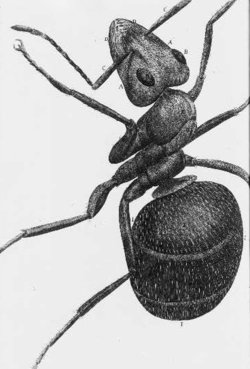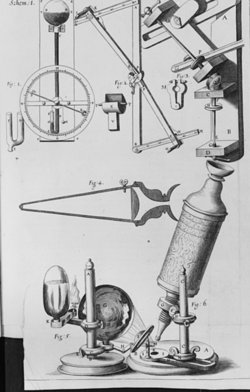Robert Hooke
|
|
Robert Hooke (July 18, 1635 - March 3, 1703), one of the greatest experimental scientists of the seventeenth century, played an important role in the scientific revolution.
Born in Freshwater on the Isle of Wight, Hooke received his early education at Westminster School. In 1653, Hooke won a place at Christ Church, Oxford. There he met Robert Boyle, and gained employment as his assistant. In 1660, he discovered Hooke's law of elasticity, which describes the linear variation of tension with extension in an elastic spring. In 1662, Hooke gained appointment as Curator of Experiments to the newly founded Royal Society, and took responsibility for experiments performed at its meetings. In 1665 he published a book entitled Micrographia, which contained a number of microscopic and telescopic observations, and some original biology. Indeed, Hooke coined the biological term cell -- so called because his observations of plant cells reminded him of monks' cells. Also in 1665 he gained appointment as Professor of Geometry at Gresham College.
Robert Hooke also achieved fame as the chief assistant of Christopher Wren, helping to rebuild London after the Great Fire in 1666. He worked on designing the Royal Greenwich Observatory and the infamous Bethlem Royal Hospital (which became known as 'Bedlam').
He died in London in 1703. No authenticated portrait of him survives, although the historian Lisa Jardine claims one portrait of John Ray represents Robert Hooke, and a seal used by Hooke displays a man's head that some have argued portrays Hooke. Both these claims remain in dispute, however.
Achievements

In addition to the book Micrographia and Hooke's Law, Hooke invented the anchor escapement and may also have invented the balance spring before Christiaan Huygens. Devices known as escapements regulate the rate of a watch or clock, and the anchor escapement represented a major step in the development of accurate watches. The balance spring also regulates the flow of energy from the mainspring of a timepiece. It coils and uncoils with a natural periodicity, allowing for fine adjustment of the period of ticks. Modern spring watches still use balance springs, and derivative designs of Hooke's anchor escapement remain in common use.
Historians sometimes credit Hooke with inventing the compound microscope, a design consisting of multiple lenses (usually three - an eyepiece, a field lens and an objective). While he did give much advice on new microscope designs to the instrument-maker Christopher Cock, this attribution appears incorrect, since Zacharias Janssen had already assembled compound microscopes in 1590. However, Hooke's microscopes achieved 30x magnification, which far outstripped the capabilities of any previous instruments.
Hooke's other significant achievements include the construction of the first Gregorian reflecting telescope and the discovery of the first binary star. He also receives credit with inventing the first practical universal joint, sometimes called the Hooke joint, although the Italian mathematician Girolamo Cardano had proposed the idea about a century earlier and may or may not have built one.
Hooke and Newton
Robert Hooke and Isaac Newton entertained a considerable mutual dislike for each other. They fell out in 1672 when Hooke criticized Newton's presentation showing that prisms split white light rather than modifying it. Newton expressed fury that Hooke seemed unable to grasp his ground-breaking discovery, and threatened to leave the Royal Society.
Relations between the men grew worse as time progressed. In 1679, Hooke wrote to Newton advocating an inverse square law of gravitation, though he lacked the mathematical ability to formally prove it. When Newton published his Principia Mathematica in 1687, including a proof of an inverse square law, he failed to credit Hooke at all.
The famous Newton quote, "If I have seen further, it is by standing on the shoulders of giants", appeared originally in a letter to Hooke, and Newton presumably intended it as a sarcastic remark directed against Hooke, who had a remarkably short stature.
External links
- Hooke Timeline (http://freespace.virgin.net/ric.martin/vectis/hookeweb/roberthooke.htm)
- http://www.roberthooke.org.uk
- The Face of Robert Hooke (http://freespace.virgin.net/iw.history/hooke/face.htm)

